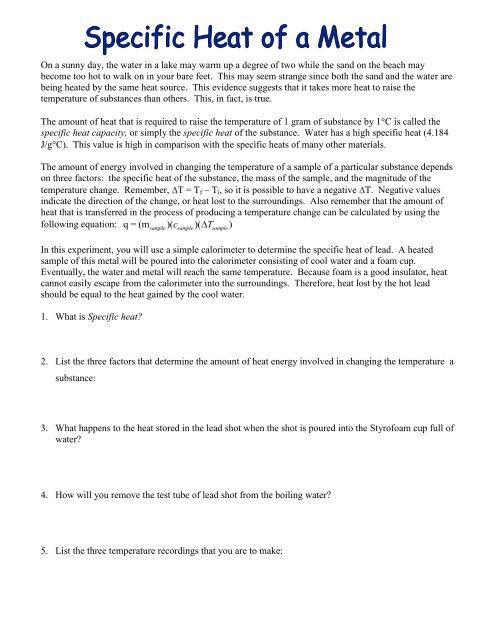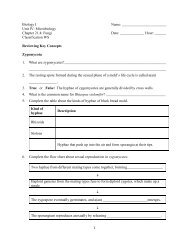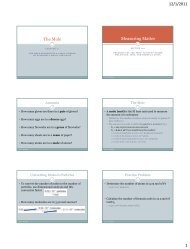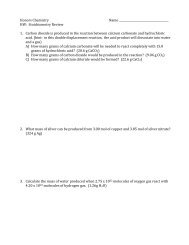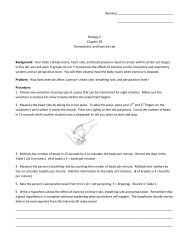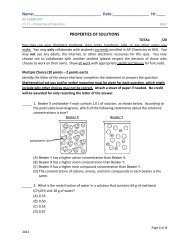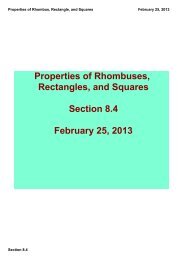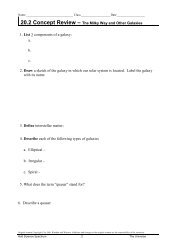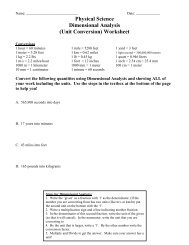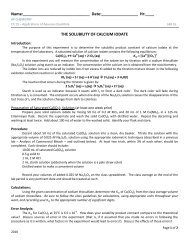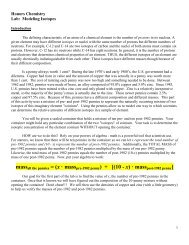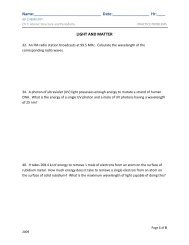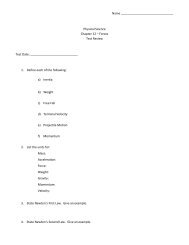Specific Heat PreLab - Honors Chemistry
Specific Heat PreLab - Honors Chemistry
Specific Heat PreLab - Honors Chemistry
Create successful ePaper yourself
Turn your PDF publications into a flip-book with our unique Google optimized e-Paper software.
On a sunny day, the water in a lake may warm up a degree of two while the sand on the beach may<br />
become too hot to walk on in your bare feet. This may seem strange since both the sand and the water are<br />
being heated by the same heat source. This evidence suggests that it takes more heat to raise the<br />
temperature of substances than others. This, in fact, is true.<br />
The amount of heat that is required to raise the temperature of 1 gram of substance by 1 C is called the<br />
specific heat capacity, or simply the specific heat of the substance. Water has a high specific heat (4.184<br />
J/g C). This value is high in comparison with the specific heats of many other materials.<br />
The amount of energy involved in changing the temperature of a sample of a particular substance depends<br />
on three factors: the specific heat of the substance, the mass of the sample, and the magnitude of the<br />
temperature change. Remember, T = T f – T i , so it is possible to have a negative T. Negative values<br />
indicate the direction of the change, or heat lost to the surroundings. Also remember that the amount of<br />
heat that is transferred in the process of producing a temperature change can be calculated by using the<br />
following equation: q = (m<br />
sample<br />
)( csample )( T<br />
sample<br />
)<br />
In this experiment, you will use a simple calorimeter to determine the specific heat of lead. A heated<br />
sample of this metal will be poured into the calorimeter consisting of cool water and a foam cup.<br />
Eventually, the water and metal will reach the same temperature. Because foam is a good insulator, heat<br />
cannot easily escape from the calorimeter into the surroundings. Therefore, heat lost by the hot lead<br />
should be equal to the heat gained by the cool water.<br />
1. What is <strong>Specific</strong> heat?<br />
2. List the three factors that determine the amount of heat energy involved in changing the temperature a<br />
substance:<br />
3. What happens to the heat stored in the lead shot when the shot is poured into the Styrofoam cup full of<br />
water?<br />
4. How will you remove the test tube of lead shot from the boiling water?<br />
5. List the three temperature recordings that you are to make:
Procedure<br />
As you perform this experiment, record your data in the data table.<br />
Lead is a toxic metal. Wash<br />
your hands thoroughly after<br />
use!<br />
1. Add about 250 mL of tap water to a 400 mL beaker. Place the beaker on a wire gauze on a ring<br />
clamp. Use a gas burner to bring the water to a boil. While the water is boiling, proceed to step 2.<br />
2. Determine the mass of a clean, dry 50 mL beaker to the nearest 0.01 g. Add about 80 grams of<br />
lead shot (Pb) to the beaker. Record the combined mass of the shot and the beaker to the nearest<br />
0.01 g.<br />
3. Construct a paper funnel to carefully transfer the lead shot to the dry test tube. Be careful to add<br />
the shot to the test tube gently so you don’t break the test tube. Suspend the test tube into the<br />
boiling water by using a utility clamp. Be sure the lead shot is below the water level in the beaker.<br />
Leave the test tube in the boiling water for at least 10 minutes. Proceed to step 4 while the lead<br />
shot is heating.<br />
4. Carefully measure out 100 mL of distilled water in a graduated<br />
cylinder and record the actual mass that you used. Pour into a<br />
Styrofoam cup. Place the cup into a 250 mL beaker for<br />
stability.<br />
Be sure to record your<br />
temperatures to the correct<br />
number of significant digits!<br />
toxic metal. Wash your<br />
hands thoroughly after use!<br />
5. After the shot has been heating for at least 10 minutes, record the temperatures of the water in the<br />
Styrofoam cup and the boiling water in the beaker. (We will assume that the Pb shot is now the<br />
same temperature as the boiling water.) These temperatures are the initial temperatures for the<br />
water and the lead.<br />
6. Remove the test tube from the bath, using the clamp as a holder. Carefully, but quickly, pour the<br />
lead shot into the water that is in the Styrofoam cup. Place the thermometer and a stir rod into the<br />
cup. Gently stir with the stirring rod (NOT<br />
the thermometer) and record the highest<br />
temperature the of Pb-water mixture.<br />
7. Drain the water off the shot and return to<br />
your teacher to be dried.<br />
8. Repeat for trial 2.<br />
9. Carefully dry your glassware for the next<br />
class.
<strong>Honors</strong> <strong>Chemistry</strong><br />
LAB: <strong>Specific</strong> <strong>Heat</strong><br />
Name _____________________________<br />
Data Table TRIAL 1 TRIAL 2<br />
Mass of 50 mL beaker<br />
Mass of 50 mL beaker + metal<br />
Mass of metal<br />
Initial temperature of water in cup<br />
Initial Temperature of metal<br />
(temperature of boiling water)<br />
Final temperature of metal & water<br />
Mass of water<br />
Data Analysis<br />
1. Calculate the changes in temperature of the water ( T water ) and of the metal for each trial:<br />
ΔT water :<br />
Trial 1 Trial 2<br />
ΔT metal :<br />
2. Calculate the heat gained by the water in each trial. (See the Introduction for an explanation of this<br />
calculation.)
3. Remembering that the heat gained by the water is equal to the heat lost by the metal, calculate the<br />
specific heat of the metal for each trial:<br />
4. Calculate your average value for the specific heat of the metal:<br />
Results and Conclusions<br />
1. Look up the accepted values for the specific heat of the metals and calculate the percent error in the<br />
specific heat value that you determined experimentally.<br />
2. Which of the data you recorded contains the greatest measurement error? Can the percent error in<br />
your specific heat be accounted for by the error in this one measurement?<br />
3. You assumed that the initial temperature of the lead shot was the same as that of the boiling water.<br />
This assumption may not have been correct and may account for some experimental error. What other<br />
assumptions were made that may be sources of error?<br />
4. List the value for the specific heat of lead obtained by three other lab groups. Do you think this<br />
property could be used to identify substances? Explain your answer.<br />
5. If you were looking for a material that was a good insulator, would you prefer a material with a high<br />
or low specific heat capacity? Explain your reasoning.


